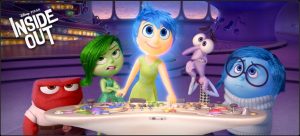02 Jul 2015 Inside Out – The Movie
Yesterday my wife and I went to see the movie Inside Out. A delightful attempt by Pixar to explain what happens inside the most complex universe known to man – our brain. We’ll definitely go to see it again, this time with our grandchildren.
And when we see it for the second and third time, we’ll strive to understand it a little better, and perhaps we can even explain some of it to our grandchildren (aged 3 to 12).
The Science:
In the meanwhile, I wanted to share with you a couple of insights that may shed some light on the complex story of Inside Out.
Emotions – We have four primary emotions: Fear, Anger, Joy, and Sadness. Although there is no unanimous scientific agreement that these constitute our core emotions, most scientists do support this notion. We also have many secondary emotions such as Jealousy, Surprise, Disgust, Love, Contempt, Shame, Relief, Hope, Pride, and more. And most scientists agree that these are derivatives of the four primary emotions.
So we’re not entirely sure why Pixar decided to include Disgust in the leading emotional team.
Memories – As we go through life our experiences are tagged with emotional labels. The stronger the experience, the stronger the emotional label, and the stronger and more vivid our memory of that event. For example, I remember very vividly where I was and what I was doing when images of the Space Shuttle Challenger exploding in midair were shown on my TV screen. Indeed, as portrayed by the movie, our memories are consolidated into Long Term Memories during the Rapid Eye Movement (REM) part if our sleep. This process is called Long Term Potentiation (LTP). Additionally, as our memories are retrieved for whatever reason, they are blended with our current experiences and re-stored in ways which could be different from the original version.
I could not find a reference to the term Core Memories, mentioned in the movie, except for as magnetic core memories used in computers and elsewhere. Interpreters of Inside Out explain that Core Memories are those that most strongly influence our self-identity.
Personality Islands – When I “Googled” Personality Islands, many results on the first, second, and even third page referred to the movie. I do not know of any scientific term referring to Personality Islands. But I assume that Pixar was thinking of a blend of core memories and core values that together constituted our sense of self-identity. I too was saddened to see Riley’s Personality Islands fall apart when she was going through a tough time in San Francisco.
Our Recommendation:
Go see the movie. And take the kids and grandkids, if you have any. You’ll have a lot of fun, and you may even experience some of the emotions on display.
References:
Dr. John Ratey – A User’s Guide to The Brain
Dr. David J. Richardson – The Emotional Life Of Your Brain




